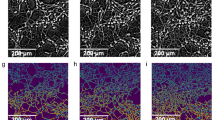Abstract
Complex networks constructed from neural correlations exhibit nonrandom structures hypothesized to be related to neural information processing. These networks can be characterized by topological features such as hubs, communities and small world connectivity. A particular network structure of interest is a clique - a fully connected subgraph - which may indicate the existence of underlying neural ensembles. We introduce a multilayer network method to observe the persistence of functional cliques over population bursts as well as their development as the underlying neural network forms connections. Using data from developing cultures on MEAs, we show that cliques become more numerous and persistent over population bursts as neural cultures age. These results provide evidence for the formation of neural ensembles in cultured neural networks.
Access this chapter
Tax calculation will be finalised at checkout
Purchases are for personal use only
Similar content being viewed by others
References
Akin, M., Onderdonk, A., Dzakpasu, R., Guo, Y.: Functional reconstruction of dyadic and triadic subgraphs in spiking neural networks. In: Cherifi, H., Gaito, S., Quattrociocchi, W., Sala, A. (eds.) COMPLEX NETWORKS 2016. SCI, vol. 693, pp. 697–708. Springer, Cham (2017). https://doi.org/10.1007/978-3-319-50901-3_55
Akin, M., Onderdonk, A., Guo, Y.: Effects of local network topology on the functional reconstruction of spiking neural network models. Appl. Netw. Sci. 2(1), 1–22 (2017). https://doi.org/10.1007/s41109-017-0044-1
Boccaletti, S., et al.: The structure and dynamics of multilayer networks. Phys. Rep. 544, 1–122 (2014)
Brunel, N.: Is cortical connectivity optimized for storing information? Nat. Neurosci. 19(5), 749–755 (2016)
Downes, J.H., et al.: Emergence of a small-world functional network in cultured neurons. PLoS Comput. Biol. 8, e1002522 (2012)
Frolov, N.S., Maksimenko, V.A., Khramova, M.V., Pisarchik, A.N., Hramov, A.E.: Dynamics of functional connectivity in multilayer cortical brain network during sensory information processing. Eur. Phys. J. Spec. Top. 228(11), 2381–2389 (2019). https://doi.org/10.1140/epjst/e2019-900077-7
Ito, S., Hansen, M.E., Heiland, R., Lumsdaine, A., Litke, A.M., Beggs, J.M.: Extending transfer entropy improves identification of effective connectivity in a spiking cortical network model. PLoS ONE 6, e27431 (2011)
Ito, S., et al.: Large-scale, high-resolution multielectrode-array recording depicts functional network differences of cortical and hippocampal cultures. PLoS ONE 9(8), e105324 (2014)
Izhikevich, E.M.: Dynamical Systems in Neuroscience. MIT Press, Cambridge (2007)
Kobayashi, R., Kitano, K.: Impact of network topology on inference of synaptic connectivity from multi-neuronal spike data simulated by a large-scale cortical network mode. J. Comput. Neurosci. 35, 109–124 (2013). https://doi.org/10.1007/s10827-013-0443-y
Massobrio, P., Pasquale, V., Martinoia, S.: Self-organized criticality in cortical assemblies occurs in concurrent scale-free and small-world networks. Sci. Rep. 5, 10578 (2015)
Niedringhaus, M., Chen, X., Conant, K., Dzakpasu, R.: Synaptic potentiation facilitates memory-like attractor dynamics in cultured in vitro hippocampal networks. PLoS ONE 8(3), e57144 (2013)
Pasquale, V., Massobrio, P., Bologna, L.L., Chiappalone, M., Martinoia, S.: Self-organization and neuronal avalanches in networks of dissociated cortical neurons. Neuroscience 153(4), 1354–1369 (2008)
Poli, D., Pastore, V.P., Massobrio, P.: Functional connectivity in in vitro neuronal assemblies. Front. Neural Circ. 9, 57 (2015)
Rubinov, M., Sporns, O.: Complex network measures of brain connectivity: uses and interpretations. Neuroimage 52, 1059–1069 (2011)
Schroeter, M.S., Charlesworth, P., Kitzbichler, M.G., Paulsen, O., Bullmore, E.T.: Emergence of rich-club topology and coordinated dynamics in development of hippocampal functional networks in vitro. J. Neurosci. 35(14), 5459–5470 (2015)
Segev, R., Baruchi, I., Hulata, E., Ben-Jacob, E.: Hidden neuronal correlations in cultured networks
Shimono, M., Beggs, J.M.: Functional clusters, hubs, and communities in the cortical microconnectome. Cereb. Cortex 25, 3743–3757 (2015)
Sporns, O.: Networks of the Brain. MIT Press, Cambridge (2010). Phys. Rev. Lett. 92, 118102 (2004)
Timme, N.M., et al.: High-degree neurons feed cortical computations. PLoS Comput. Biol. 12, e1004858 (2016)
Vaiana, M., Muldoon, S.F.: Multilayer brain networks. J. Nonlinear Sci. 30(5), 2147–2169 (2018). https://doi.org/10.1007/s00332-017-9436-8
Wagenaar, D., DeMarse, T.B., Potter, S.M.: MeaBench: a toolset for multi-electrode data acquisition and on-line analysis. In: 2005 2nd International IEEE EMBS Conference on Neural Engineering, Conference Proceedings, pp. 518–521 (2005)
Yuste, R.: From the neuron doctrine to neural networks. Nat. Rev. Neurosci. 16(8), 487–497 (2015)
Zeldenrust, F., Wadman, W.J., Englitz, B.: Neural coding with bursts-current state and future perspectives. Front. Comput. Neurosci. 6(12), 48 (2018)
Author information
Authors and Affiliations
Corresponding author
Editor information
Editors and Affiliations
Rights and permissions
Copyright information
© 2022 The Author(s), under exclusive license to Springer Nature Switzerland AG
About this paper
Cite this paper
Akin, M., Guo, Y. (2022). Emergence of Stable Functional Cliques in Developing Neural Networks. In: Benito, R.M., Cherifi, C., Cherifi, H., Moro, E., Rocha, L.M., Sales-Pardo, M. (eds) Complex Networks & Their Applications X. COMPLEX NETWORKS 2021. Studies in Computational Intelligence, vol 1073. Springer, Cham. https://doi.org/10.1007/978-3-030-93413-2_52
Download citation
DOI: https://doi.org/10.1007/978-3-030-93413-2_52
Published:
Publisher Name: Springer, Cham
Print ISBN: 978-3-030-93412-5
Online ISBN: 978-3-030-93413-2
eBook Packages: EngineeringEngineering (R0)




